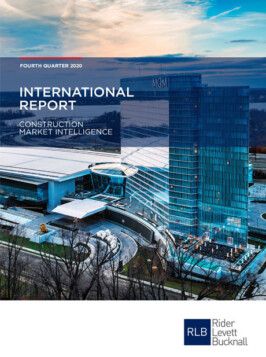According to the Rider Levett Bucknall (RLB) 4th Quarter 2020 International Report, the six-month period to the end of 2020 saw economies across the globe struggling in various ways to deal with virus transmission, and to ensure that health services were not overwhelmed, while at the same time, trying to maintain a viable economic position in the face of unprecedented adverse conditions.
RLB’s Oceania Research and Development Director Domenic Schiafone said,
‘Our offices around the world have reported their views on local conditions and changes that have taken place, to provide a tapestry of local impacts to this global phenomenon. Globally, the effects are obvious from a health management perspective.’
‘However, regionally and locally, impacts and responses vary. Local construction economies’ responses have been set against the backdrop of global circumstances, particularly in respect to key sectors of the overall market,’ he added.
Domenic continued, ‘Some, including retail, hotel and leisure and travel and sport have been widely and consistently badly affected, while others such as health, data centres and industrial and logistics are actually experiencing significant sector-growth as activity patterns have been forced into rapid change.’
Looking forward, RLB expects a two-speed recovery will shape how contractors look to fill their pipelines of work. Competitive tender pricing will occur in those sectors where volumes are expected to maintain historical levels or even grow, as contractors attempt to move from negatively impacted sectors to gain work.
This edition of the RLB International Report considers what has happened, and what is projected to take place over the upcoming period, to set the scene for the advent of inoculation and an end-of-pandemic phase. Much is as yet uncertain, much depends on timing and efficacy of vaccination variants, but for construction, change will take place, likely specific sector-led and likely significant for the future of construction around the world.
Africa
According to RLB, it is difficult to quantify or predict the long-term effect that COVID-19 will have on the South African building industry. The current situation is that the building industry is again in lockdown until April 2021, with some exceptions. Now that the construction industry is adapting to its new normal, with its increased cost base and productivity and scheduling challenges, many parties are looking to address the impacts of COVID-19 upfront in their contracts to the extent possible.
More recently, the pandemic has led to job losses and fewer construction projects going ahead because of the hard lockdown.
South Africa’s economy rebounded in the third quarter of 2020 (July–September), coinciding with the easing of COVID-19 lockdown restrictions. According to the South African Reserve Bank, construction activity (Gross Value Added) increased 31% in Q3 2020 from the low in Q2 2020. The result is still 10% below the same quarter 12 months ago.
Middle East
The Kingdom of Saudi Arabia (KSA) went through a period in 2020 where borders were closed. This has now eased for materials and supplies, however labour is currently unable to access KSA directly from a list of 22 countries, without a 14-day isolation period in a ‘safe’ location. There is currently a curfew, which is not affecting construction operations directly, beyond restricting vehicle movements during this time.
The United Arab Emirates has provided a robust and coordinated response to the COVID pandemic, which has seen the ratio of COVID-related deaths in the community being some of the lowest in the world and achieving one of the highest vaccination rates so far.
The construction sector has weathered some of the worst effects following the government’s decision to designate it as an essential economic sector, which has enabled projects under construction to continue building under clear safety guidelines. Property and development will however continue to feel the increased pressure of the local and global macro-economic impacts of the pandemic.
Within both the UAE and Qatar, RLB has seen no significant cost impact from COVID. Slight reductions in escalation as pressure to reduce rates and tender prices has been widely applied.
North Asia
China’s major infrastructure companies achieved double-digit growth in new contract values despite the coronavirus pandemic, which interrupted the movement of people and goods during 2020. This better-than-expected outcome was mainly due to the government’s infrastructure construction stimulus to stabilise and grow the domestic industry. For example, China Railway Group saw new contracts increase by 20% on a year-on-year basis.
Although the 2.3% annual increase in activity for the world’s second biggest economy was its slowest since 1976, by the final three months of last year China was expanding at a faster rate than before the crisis. To suit the housing demand in the next decade, the government has identified 330 hectares of land for supplying about 316,000 public housing flats from reclamation in Tung Chung, the agricultural land and brownfield sites in new development areas, etc. Moreover, the government would continue to spend over $100 billion on average on the development of infrastructure annually.
South Asia
At the conclusion of 2020, the construction industries of the South East Asia region continued to face major challenges, from global lockdowns slowing the flow of imported materials and equipment, international border closures restricting the movement of foreign workers, to the closure of construction sites.
Within Singapore, demand for projects by the private sector is unlikely to return to pre COVID-19 levels, as investors are likely to remain cautious. Hence, demand in 2021 is expected to be between $8 billion to $10 billion – similar to the figure of $8.1 billion in 2020, a drop from $14.5 billion in 2019.
Across the region, despite the fall in demand, costs have risen for firms in the past year. Increasing material costs, uncertainty in the market and technology adoption will continue to remain as cost drivers in the industry. Labour market volatility will continue until the labour crunch can ease. As for technology adoption, there are always capital costs that come along with picking up new processes, and given that there are still many changes, there is a lot of work to be done before we will see the results.
North America
RLB’s International Report found that the coronavirus pandemic impacted severely on the US economy throughout 2020. The residential construction market has outperformed the wider economy and bounced back from the initial shock of the COVID-19 outbreak, which has left millions of people out of work. Demand for new homes remains extremely high. The lack of existing homes for sale, plus renewed interest in suburban living amid the pandemic, is pushing buyers further out from major cities and toward newly constructed developments. But price pressures could begin to affect builders and buyers alike in the coming months.
Canadian construction starts fell 22.3% in 2020, following on from a 12.3% decline in the previous year. New Canadian construction is now at its lowest level since 2016. Although there were restrictions on construction activity in Quebec and Ontario, large projects earlier in the year limited the extent of the annual decline. More worryingly, the decline in Canadian starts accelerated through the course of the year, reaching a 43.4% year-on-year contraction in Q4.
While material and labour costs rose in 2020, weak demand led to more aggressive bidding from contractors in order to secure a pipeline of work. As a result, total construction costs remained roughly flat. The expectation is that contractors will begin to increase margins once the market recovers. The cost of movement of freight from both Europe and Asia to the US has seen significant increases during the year due to shortages in container availability and port congestion, that continues to delay ships and container movement, causing higher freight cost for imported construction materials.
Australia
COVID-19 has certainly impacted on future construction activity volume. However, the exact impact of the pandemic is difficult to quantify because activity in 2021, and beyond, was already expected to decline. In particular, sectors classified as high performers in recent years—high density residential, office, hotel and retail—have taken the brunt of the current downturn and are all predicted to decline over the coming years. This is not surprising, given that these sectors are historically driven by strong net migration, influxes of international students, strong employment growth in the financial and service industries, and positive tourism activity—all of which have diminished since the outbreak of COVID-19 in March 2020.
Stable pricing is forecast for 2021 in most cities, with modest increases in escalation expected. This could change quickly if demand heats up or significant disruptions to supply chains (insolvencies, surge in material prices due to global trade conflicts and lack of skilled trade personnel) occur. Current indicators however suggest a more tepid path.
Looking ahead into 2021, RLB sees strong demand in the infrastructure, health and industrial sectors, while weaker activity will be seen in the high-rise residential, hotel and offices sectors. Repurposing and/or the refurbishment of retail and office space may also emerge as a strong performer, with building owners and landlords looking for new opportunities.
New Zealand
COVID-19 continues to be a major influence on the New Zealand and international economies. Net migration, which had previously been a key driver of population growth and hence residential accommodation demand, has virtually stopped. In the six months to September, net migration of all citizenships was 2,500, compared with an average of over 20,000 in the same period in recent years.
The inability to source workers, given border restrictions, from overseas may exacerbate these labour shortages. Nonetheless, we expect that increased capacity in the sector will largely weigh on construction cost escalation over the coming year.
From late 2021, RLB expects a pick-up in construction cost escalation as the acceleration in construction activity sees capacity pressures build up modestly in the sector. Recognising the higher than usual degree of uncertainty over forecasting in these times, we expect annual construction cost escalation to pick up gradually from a trough of 1.4 per cent in March 2021, to around 3.2 per cent by mid-2024.
United Kingdom
Across the country, the combined effect of the economy having been effectively shut down for two periods of time, and the construction industry having to implement defensive measures against virus transmission, have resulted in a fading away of any real scope for tender price increases. In many locations, there is still ample workload, but the timescales of that work have been lengthened somewhat, with a corresponding effect on the cost of preliminaries, alongside the actual additional costs of health and safety measures.
The overview is that, despite upcoming mass inoculation, the UK construction industry is still in need of an injection of certainty to ease the risk burden on estimators and companies’ directors. Over the coming period, workload availability will be vital, but the challenge will be to achieve viability within the overall competitive framework.
Continental Europe
While in general terms, adversely affected sectors in Europe have been in line with those sectors which have been particularly impacted elsewhere, namely hotels, hospitality and tourism, commercial, retail and sport, local effects depend upon national government measures. Indeed, where markets have been stimulated, there are reported signs of overheating, while in other locations, investor nervousness is holding back decisions. In other environments, there are moves to ease planning constraints, yet in many places, there is resistance due to foreseen adverse effects ‘down the road’.
The overall effect is a significantly impacted construction industry across all of the countries that comprise the region, but despite the supposed consistency of approach represented by the European Union, there are many and varied local responses to maintaining a vibrant construction economy. This is, of course, a logical outcome of differing real-lived experiences of attempting to suppress the R-number, but it will eventually have to be rationalised after the pandemic, as contractors and the larger, more mobile sub-contractors trade in a largely borderless market, where there are few barriers to cross-border working.
FURTHER INFORMATION:




